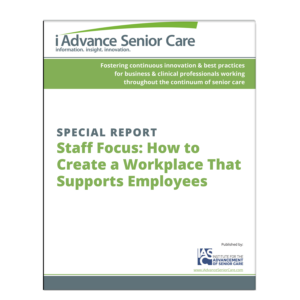Does Staffing Mean Quality?
| I heard an interesting dialogue at a recent long-term care'related conference I attended. I won't name the conference or the participants because I don't think their comments were intended for national publication, but it was the content of those remarks that was of most salient interest anyway. It started up after a CMS official during a panel discussion commented on current Medicare "pay-for-performance" work at his agency-specifically, whether nursing facilities taking active steps toward modernizing their information technology would be rewarded with a reimbursement upgrade. A nursing home administrator in the audience got up and, while noting that the IT reward was a good idea, asked why CMS considered using staffing ratios to determine pay-for-performance rewards. Just the fact of having a relatively large staff wasn't necessarily an indicator of quality, he said; it was only an input, not an output. It was conceivable that with good information technology, fewer staff might be needed to produce good quality care. Why wouldn't facilities be rewarded for bringing that off? "I don't think we're running a full-employment program," he added. However, a well-known and respected long-term care policy analyst in the audience responded that the professional literature was replete with studies associating high staffing ratios with quality and, therefore, reimbursement rewards based on staffing alone would be supported by evidence. The CMS official was (surprise, surprise) noncommittal about all this, and any resolution of the question was left hanging. But the exchange had provoked thought, at least for this observer. The administrator was correct, in my view, in that bodies alone don't necessarily indicate that a quality job will be performed (as any Army veteran will tell you). Yet, as the long-term care analyst indicated, studies-at least in this field-have made that connection. The point was driven home to me by a memory of a visit to a Dutch long-term care facility several years ago. I remember walking past the common room and seeing staffers just sitting around chatting with residents in small groups of two and three (a pretty nifty ratio of 1:2 or 1:3). The administrator made the point that this relaxed conversational mode, staffing-heavy though it was, seemed to keep the residents calm and engaged in their surroundings-in short, the human touch exemplified. Might it be, I wondered, that in long-term care, we simply have to accept the proposition that this is a people business, and the more people the better? But then, acknowledging that staffing is the priciest input of all, what would the economic justification be, the return on investment, for facilities with enhanced staffing? Should they expect better census because of word-of-mouth reputation? Should government programs pay them more just for staff? But then what about the possibility of technological substitution for staff, perhaps allowing for better communication at a lower cost, as alluded to by the administrator? Should we avoid entertaining any possibility of this whatsoever? I don't know that anyone has hard-and-fast answers to any of this. But we have to look for and engage with some answers, as we reshape our approach to meeting the 21st-century challenges of long-term care. To comment on this editorial, please send e-mail to peck0706@nursinghomesmagazine.com. |

Richard L. Peck was editor in chief of I Advance Senior Care / Long-Term Living for 18 years. For eight years previous to that, he served as editor of the clinical magazine Geriatrics. He has written extensively on developments in the field of senior care and housing.
Related Articles
Topics: Articles , Staffing











